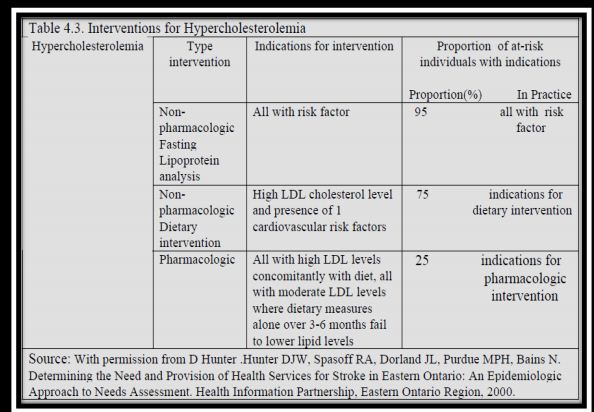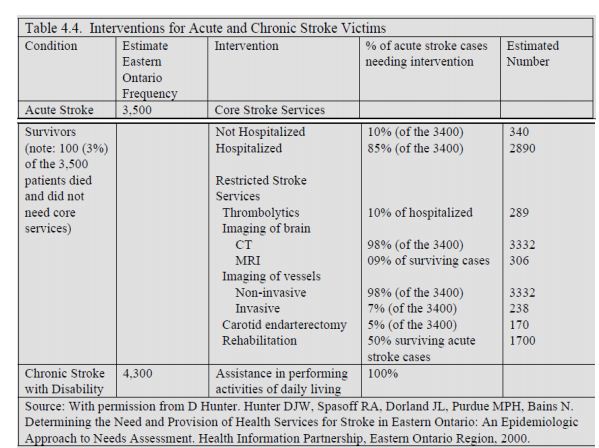Discuss the following:
Needs Assessment For Stroke Services In Ontario, Canada
The Queen's Health Policy Research Unit (QHPRU) estimated the need for stroke services in Ontario, Canada using measures of prevalence and incidence of (1) modifiable and nonmodifiable risk factors for stroke; (2) acute cases of stroke; (3) major sequelae of stroke (Hunter D , 2000 and Hunter D, 2004). They identified the effective health services that are targeted at each of these three dimensions, and linked these steps to estimate need for health services. They compared the estimate of need for health services to compiled measures of levels of stroke-related health services in Eastern Ontario to see if there was a gap (unmet need) or surplus (overmet need) of these services. The numbers below have been changed slightly from the original source.
QUESTIONS
1. Risk factors for stroke include heavy alcohol consumption, atrial fibrillation, diabetes, hypercholesterolemia, hypertension, obesity, low physical activity, smoking, ischemic heart disease, transient ischemic attack. Where might QHPRU get estimates of the incidence of these
conditions?
2. For each risk factor, or stroke sequelae, QHPRU listed the kind of intervention that would be effective, and the proportion of people for whom this intervention would be appropriate. According to Table 4.3, which three interventions are appropriate for hypercholesterolemia, and for what proportion of high-risk individuals?
3. The following types of interventions were recommended for acute stroke services: (a) surgical intervention (carotid endarterectomy); (b) thrombolytic therapy; (c) imaging of the brain, either computed tomography (CT) or magnetic resonance imaging (MRI); (d) non-invasive imaging of the vessels (ultrasonography or magnetic resonance angiography); (e) invasive imaging of the vessels (cerebral angiography); (f) rehabilitation therapy. For what percent of at-risk individuals are these services recommended?
4. Estimates of people in Eastern Ontario with hypercholesterolemia are as follows: aged 25-44: 30,000 men and 13,000 women; aged 45-64: 33,000 men and 42,500 women; aged 65 and above: 17,000 men and 42,000 women. How many residents in Ontario will need fasting
lipoprotein analysis and dietary and pharmacologic interventions for hypercholesterolemia?
5. It is estimated that Eastern Ontario provides dietary and pharmacologic intervention for hypercholesterolemia to 66,000 and 15,500 patients respectively. What is the level of unmet need in terms of the number of patients not receiving each of these two recommended interventions? What percent of need is not currently being met in Eastern Ontario?
6. The incidence of acute stroke cases was estimated at 3,500 cases, 100 of whom died before reaching the hospital. The prevalence of chronic stroke cases was estimated to be 4,300. Use Table 4.4 to estimate the number acute and chronic stroke cases needing core stroke services, and services for chronic stroke and disability.
7. It is estimated that Eastern Ontario provides thrombolytic therapy and carotid endarterectomy to 50 and 200 patients respectively. CT and MRI brain imaging is provided to 1,000 and 150 patients respectively. Non-invasive and invasive imaging of the vessels is provided to 425 and 170 patients respectively. Rehabilitation is provided to 1,400 acute stroke survivors, and homecare services are provided to 1,400 chronic stroke with disability patients. What is the level of unmet need in terms of the number of patients not receiving each of recommended services for acute or chronic stroke victims? What percent of need is not currently being met in Eastern Ontario?

